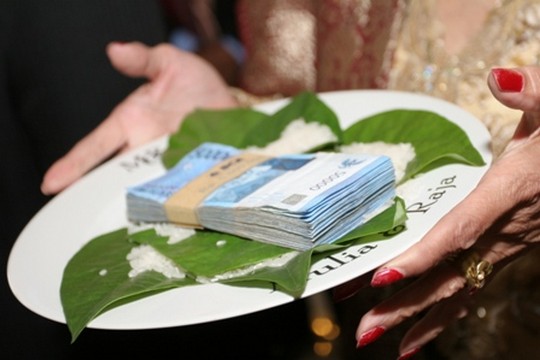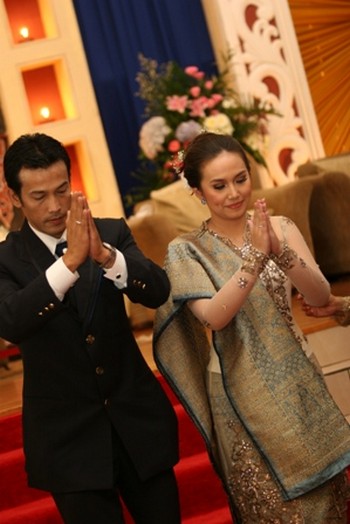Money matters when preparing an upper middle class Batak wedding in Jakarta
Deasy Simandjuntak
Dressed to the nines: weddings of the rich combine extravagance withtraditionFrom the private collection of Mrs. Putri Anna Sylvia Siagian-Simanjuntak |
Conspicuous consumption and displays of luxury are emblematic of Jakarta’s upper middle class. Higher education, the cultivation of distinguished acquaintances, holidays abroad, a large house in a gated community, expensive cars – all are must-haves for those wanting to belong. These things set them apart from the kampung riff-raff, who do not seem to prize private possessions. However, this does not mean one can ignore traditional practices, or adat. Especially not when there is a Batak wedding.
Sandra Sitorus had just returned home from Europe after completing her master’s education. On the first Sunday after her arrival, she could be seen reluctantly trailing behind her parents to the Batak Protestant church that the family frequents in South Jakarta. The family wished to parade their daughter as a talented young lady with an overseas education. Moreover, friends and relatives should know that Sandra was still single.
Unfortunately however, most relatives pitied rather than admired Sandra. She was in her late twenties, with a darkish – not quite desirable – facial complexion. And she seemed uninterested in romance. Most other females of her age in the extended family had found a husband, and the rest were in long-term relationships. Some aunts, determined to solve her problem for her, had embarked on a range of tactics to persuade Sandra to accommodate pre-arranged courtships. Alas, to little avail.
After church Sandra went with her parents to her uncle’s house. The large and well-organised extended family was meeting to discuss the upcoming wedding of Sandra’s cousin Johann. By showing her these preliminary spousing rituals, Sandra’s parents clearly hoped to stimulate her own nuptial curiosity.
Old money
Sandra’s uncle’s family, the Harianja, lived in the celebrated area of Menteng in Central Jakarta. Every connoisseur knows this neighbourhood as a haven for old money. The Harianja’s vicinity proudly hosts ex-state ministers, party leaders and intellectuals. As their car pulled up in front of the two-storey Greek-pillared house, Sandra noticed that all the uncles and aunties had already arrived. Drivers were chatting beside rows of parked cars. At the gate were security guards, some uniformed. Behind it, giggling maids still held garden hoses and bamboo rakes in their hands.
The meeting started as soon as Mr and Mrs Sitorus had taken their seats in the stately living room. In the corner, a dusty black grand piano stood as a silent witness to the endless music courses the children had taken when they were young. Johann sat sandwiched between his parents and listened as his uncles spoke about the family of the bride-to-be. Johann had returned from his station at an oil rig in the Middle East especially to attend these preparatory meetings. Today’s topic: how much money was the Harianja family prepared to send to the girl’s family? Determining a Batak dowry involves a delicate balancing act between honour, tradition, and sound financial judgment. Too little would be a disgrace, too much a waste. The sum also depends on the qualities of the bride. A girl from an unblemished family, with a foreign MA, will nowadays fetch up to $US9000.
Determining a Batak dowry involves a delicate balancing act between honour, tradition, and sound financial judgment
The dowry the groom’s family pays the bride’s is called tuhor (payment) or sinamot (wealth). Many other ethnic groups practise a similar system. Javanese give mahar or mas kawin in the form of money or jewelry. The Minang from West Sumatra do the same, but there the bride’s family pays a dowry to the groom’s. Despite its literal meaning, the Batak tuhor does not mean daughters are bought and sold in marriage. It is a token of gratitude to the bride’s family for allowing their daughter to become the mother of the groom’s descendants. The bride does not relinquish her own family.
In the past, the immediate family of the bride received only a small portion of the dowry. The larger part was allocated to various relatives of the bride, in accordance with intricate customary regulations (adat). These days the tuhor is largely used to finance the extravagant ceremonies and festivities. And of course the precise amount of tuhor becomes a delectable topic of gossip, which can make or break the lofty reputation of either family.
Appearances
Upon learning that the in-laws-to-be were connected to one of Jakarta’s most prominent law offices, Johann’s extended family agreed the finances for the wedding party should be generous to a fault. Appearances were decisive here. ‘They know who we are, we have doctors in the family, and we are high in government,’ Johann’s mother maintained. ‘We can’t be seen as cheap.’
 |
A crucial part of the celebrationsFrom the private collection of Mrs. Putri Anna Sylvia Siagian-Simanjunta |
One aunt whispered to Sandra: ‘Her parents are lawyers. Her father pays his employees in US dollars.’ Overhearing this, another aunty sitting close by chipped in: ‘Yes, but Johann’s salary is also in US dollars.’ She lowered her voice: ‘Eight thousand dollars a month, for a first salary! Can you imagine?’ As the meeting tried to settle on a dowry somewhere between US$10000 and 12000 , the ladies continued to murmur among themselves. Johann had already purchased a luxurious apartment in Central Jakarta. The bride had a very agreeable light complexion. As to what she did for a living herself, no one seemed to be bothered. Her family was prosperous, she would not need to work at all.
An uncle jokingly remarked that the alliance between the two families would indeed be perfect. ‘We’re bureaucrats and generals, they’re lawyers’, he chortled. ‘We’ll always win in court!’ The conversation then drifted to the fact that ‘the government’ had its tentacles on upper-echelon bureaucrats everywhere, restricting their freedom of movement. And not just on bureaucrats. An old friend and neighbour who was a senior member of the political party PDI-P (Indonesia Democracy Party-Struggle) was now in custody for alleged corruption.
An uncle jokingly remarked that the alliance between the two families would indeed be perfect. ‘We’re bureaucrats and generals, they’re lawyers’, he chortled. ‘We’ll always win in court!’
Telephone exchanges and face-to-face meetings between the two extended families followed over the next several days. The result was that the wedding party would be jointly financed by the bride’s and the groom’s families. The venue would be the luxurious Balai Sudirman in Central Jakarta, which could host up to 3500 guests, with a minimum of 1700. They charged US$3000 for the use of the building for four hours, and US$170 per guest for the buffet meal. The bride and groom planned to have professional photographers take their pictures before the wedding. This is trendily known as a ‘pre-wed’ in young couples lingo in Jakarta. A good photo studio charges around US$250 for ten photos.
There would be many other costs, none less important than the other. The ladies were already consulting on the colour and patterns of their brocades. Uniform brocades for the ladies of one family line are a wedding convention. Every uniform would be handmade by each lady’s favourite dressmaker. The fee was pricey, though of course not as pricey as the bride’s dress, which would cost up to US$1000, especially if it was to be created by a celebrated fashion designer, as is the custom for well-to-do brides in Jakarta.
Festivities
A Batak wedding requires several festivities. First comes the engagement ceremony at church, which requires boxes of snacks for guests. Several weeks later comes the church wedding ceremony, which is when the photographers and film-maker begin their work. The church wedding is followed by the adat ceremony later the same day at a large rented venue. In the past, this took place at the bride’s home and involved the whole village. Today’s list of invitees is too long for even a spacious modern house. The traditional rajas, prominent representatives of various clan branches connected to the bride and groom, and their families, are summoned to give blessings. The adat ceremony lasts up to seven hours. Only then, or sometimes on the next day, does the happy but already exhausted couple move on to the mega-expensive reception.
During one of these parties, an aunt turned towards Sandra. ‘Look here, dear niece’, she said in a low voice, ‘my distant cousin’s son is finishing his PhD at Virginia Technology University.’ She took a short breath after that mouthful of a university. ‘I have given his mother your phone number. They’ve lived in the States for years! I understand you modern young people would never marry somebody who lives in Indonesia. Your mentality is already different.’ Sandra tried to hide a chuckle. She had been listening to comments on her ‘mentality’ ever since she arrived back from Europe. Everyone assumed she had become unwilling to succumb to traditional, ‘backward values. They all believed she remained single because she had developed a ‘modern’ or ‘westernised’ outlook.
‘He’s not stupid, you know’, added her aunt, ‘if that’s what you worry about. His scholarship is from NASA. He’s surely going to be recruited once he finishes school.’ The aunt reflected dreamily how nice it would be to live in the US. She had been there once visiting a distant niece who taught at a prominent university in California. ‘But of course he’s not young’, she mumbled, ‘he’s 42. Then again, you’re not getting any younger yourself, eh?’
Deasy Simanjuntak (deasysim@gmail.com) received a PhD from the University of Amsterdam in 2010 with a dissertation entitled ‘Who shall be raja? Patronage democracy in North Sumatra, Indonesia.’ All names have been changed.
This article is part of The Rich in Indonesia feature edition.













